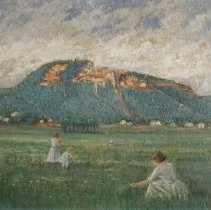Object Record
Images

Metadata
Object Name |
Painting |
Catalog Number |
1981.056.01 |
Description |
Oil painting of Grandad Bluff by Charles Loveland on canvas. There are children picking flowers in a field with the bluff in the background. |
Year Range from |
1910 |
Year Range to |
1920 |
Provenance |
Made by Charles Loveland, one of the founders of Northern Engraving. James Christell and James Novak were the original founders, but Charles Loveland came in and was made a co-partner in 1915 after Christell retired. It was still a new business when Loveland was involved and he helped form the company. |
Image size |
12 x 14.5 inches |
Signature Location |
Bottom Left |
Signed Name |
CA Loveland |
People |
Loveland, Charles |
Subjects |
Art "Things that Matter" |
Search Terms |
Northern Engraving Company Grandad Bluff "Things that Matter" |
Notes |
Featured in Things that Matter Featured in Things that Matter This idyllic oil painting by La Crosse artist Charles Loveland evokes a dreamy image of a simpler time. A woman and three children dressed in white pick flowers in a field in front of the bluffs. The foreground bluff appears to be Grandad Bluff, based on quarrying evident at the top. Loveland was born in La Crosse in 1881, and he resided here his entire life. In addition to being an artist, he was instrumental in two La Crosse businesses, the Aiken-Gleason Camera Co. and Northern Engraving. As a young man, Loveland worked for the Aiken-Gleason Camera Co. at Seventh and La Crosse streets — by 1901, it was the Imperial Camera Co. — in the production of folding-view cameras. Imperial was sold a few years later, becoming Conley Camera of Spring Grove, Minn. For a few years, Loveland was listed in city directories as either an artist or a shipping clerk for the Pamperin & Wiggenhorn Cigar Co. In 1907 he married Clara Ebner, and the young couple began a family, eventually raising four children — Ruth, Charles Jr., Donald and Warren. Loveland began work with the fledgling Northern Engraving Co., a photo-engraving and nameplate manufacturer, as a commercial artist and partner with James Novak about 1915. He soon moved his wife and then three young children to 21st Street at the edge of the city near the base of Grandad Bluff. At this time, the eastern edge of La Crosse was open fields and farmland. Loveland’s oil painting is undated, but it may have been from this period. The woman in the painting is dressed in clothing popular in that era, as are the children. Loveland may have imagined this scene, or he may have portrayed his wife and three children in a field near their new home. Loveland rose through the ranks to become Northern Engraving’s treasurer by 1922 and its president by 1932. He and his family later moved to an elegant home near Cass Street and West Avenue. He remained Northern Engraving’s president through at least 1948. Loveland died in 1951, and he is buried in La Crosse’s Oak Grove Cemetery. Whether Loveland’s painting represented an informal family portrait or a fantasy, its historical interest is undeniable. The painting shows us how different the young city of La Crosse and its bluffs looked about 100 years ago. This article was originally published in the La Crosse Tribune. Title: Painting of Grandad Bluff Author: Carole Mullen Publish Date: April 28, 2018 |